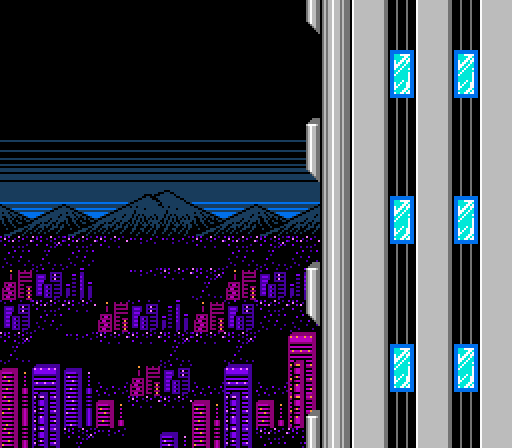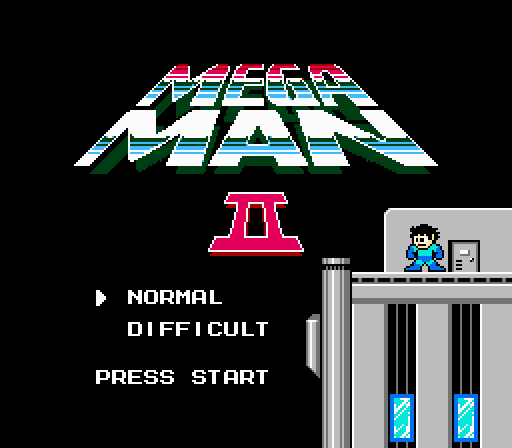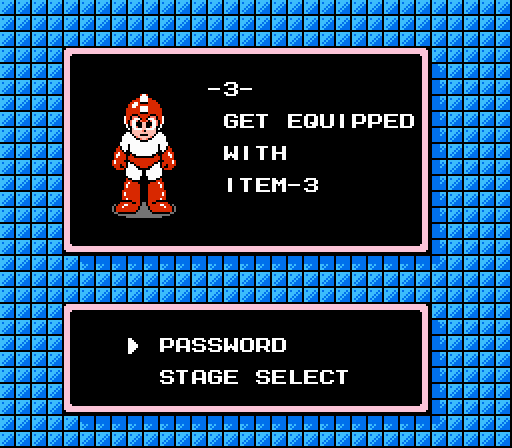First sequels on NES have a reputation for going wildly off the rails and taking a budding series in strange directions — into a new genre, sometimes. In truth, this reputation comes from a few high-profile titles, mostly from Nintendo; two of them (Simon’s Quest and Zelda II) have spent time under the Anatomy of Games microscope. The majority of NES sequels simply tried to beef up their predecessors’ audio-visual oomph, refine the game mechanics, and embrace a larger and more ambitious sense of scope.
Mega Man 2 falls into the latter category. It carries forward the rules, feel, and structure of its predecessor. But it looks better. Sounds better. Plays better. There’s more purpose to it, more structure. It is better in every possible way than the original game.
Make no mistake, Mega Man was hardly a dud. For its time, it was a pretty fantastic game; it followed directly in the style of Capcom’s own Ghosts ‘N Goblins and Bionic Commando, perhaps not surprisingly given that both arcade games had been helmed by Mega Man co-creator Tokuro Fujiwara. Like Arthur and Super Joe, Mega Man could run, jump, and shoot while navigating harrowing hazards and tricky platforms.
But in moving from arcades to consoles, Fujiwara and company explored a format better suited for the home, where players could return to the game at their leisure. They broke down the progression of levels into a nonlinear form, allowing players to leap into any of the game’s first six stages in any order. They rewarded players for completing stages by giving them an additional weapon that could be used to solve certain problems or situations within various stages, and which granted them a strategic advantage over the game’s bosses.
But Mega Man wasn’t perfect. The physics weren’t always cooperative. It featured some needlessly difficult platforming sequences. Bosses were wildly unbalanced, and there was no consistency in the strength of your supplementary weapons. Many of the special powers you earned were utterly situational, resulting in their being neglected throughout most of the game. And the one “weapon” that wasn’t earned by defeating a boss could be completely missed, allowing you to reach a late-game sequence where it was required without having acquired it and forcing you to retrace your steps. Mega Man 2 fixed all of these shortcomings.
The game begins on the title screen, which riffs on the first game’s ending: You get a close-up view of the futuristic city that scrolled past in the background as Mega Man ran back home to Dr. Light’s lab, and the ending theme to Mega Man plays. A slow drip-feed of text recaps the plot of Mega Man and sets up the new scenario: Upon the defeat of his plan to take over the world by corrupting Light’s six Robot Masters, Dr. Wily created eight new masters of his own and declared his mad ambition to take on the world anew.

The music rises to a crescendo… but instead of rolling into the upbeat credit scroll passage from Mega Man, it’s overtaken by a new melody that fades in and takes the lead. The screen begins to scroll upward along the length of the skyscraper in the foreground, and the cityscape recedes, giving way to night. The melody ascends in time with the camera until we reach the building’s peak, where Mega Man stands alone looking out over the city, his robot hair waving in the breeze.

An intense musical theme kicks in and continues playing until you press Start, at which point Mega Man’s helmet materializes to cover his hair and he warps into action.
Welcome to Mega Man 2.

As soon as the game begins, you can already see the first major improvement over the original Mega Man. Two, really. Not only does the game look much nicer than its predecessor, it also includes a password feature. Now you no longer need complete the game in a single sitting; you can complete a few stages and return to the game later. This turns out to be a handy feature, given what you see on the stage select screen upon beginning a new game. The six Robot Master levels of Mega Man have now become eight, making for more content to complete and more weapons. That means more strategic options once equipped with gear, and more need to experiment with skills and weaknesses.

Once you venture into the game, you’ll notice a few significant changes. First, the scoring feature is gone; Mega Man 2 drops Mega Man’s scoreboard, which honestly was vestigial to begin with. This means vanquished enemies no longer drop those little pellets that you could collect for points. Robot Masters no longer have random-but-not-really point values. Mega Man 2 gives you a single purpose, a single mission: Defeat Dr. Wily and his robots.
In the U.S. version, you’re given a choice of difficulty settings: “Normal” or “Hard.” For the purposes of this series, we’ll be dealing with Hard, as it was the standard difficulty in the original Japanese release. The much easier “Normal” mode was added for the U.S. version, because Mega Man 2 predates the advent of widespread video rentals. Once the rental market took off, the U.S. versions of games were usually re-tuned to be harder, diminishing the likelihood of people completing them on a weekend rental and deciding not to buy it.

Another major change in Mega Man 2 over the original comes in the non-weapon supplemental tools. The Magnet Beam is out, replaced by three different items that Dr. Light gives you as you complete different stages. You cannot complete Mega Man 2 without Item-1, -2, and -3, but at the same time you can’t get the points that they’re required without having collected them. In this and many other respects, Mega Man 2 greatly reduces the amount of trial-and-error required to complete the game and places more emphasis on experimentation and skillful use of Mega Man‘s arsenal.
And, all in all, the game just feels better. Mega Man looks the same as before, but he moves more responsively than before. Even little details, like the new design of health pickups, makes the game feel sleeker… crisper. Mega Man spends less time reeling and doesn’t fall back as far when he takes a hit; his behavior when you return from the weapon select menu while climbing a ladder is different, too. There’s less likelihood that when you die it was because the game treated you unfairly. Capcom also removed the pause button altogether; now, you go to the weapon sub-screen to pause the game, preventing exploits like the Thunder Wave multi-hit trick. Then again, there are no unreasonably difficult bosses this time around to create the need for that exploit; Mega Man 2 is a far better balanced game than the first, with only two unreasonably difficult sequences to contend with — and even those can be skipped over or otherwise nullified quite easily.
With this sequel, a perfectly solid game gave rise to a genuine masterpiece.

“The much easier “Normal” mode was added for the U.S. version, because Mega Man 2 predates the advent of widespread video rentals. Once the rental market took off, the U.S. versions of games were usually re-tuned to be harder, diminishing the likelihood of people completing them on a weekend rental and deciding not to buy it.”
Instead, people cursed at how soul crushingly difficult those games were and still decided not to buy them. Damned if you do, damned if you don’t.
Speaking of Mega Man 2 and difficulty settings, I found it pretty interesting how the Mega Man Anniversary Collection port (which is based on the PSone port, I assume) handled its own difficulty options. Mega Man 2’s US Normal just doubled the damage you dealed to enemies. The MMAC/PSone version’s easy mode had you only do 1.5 times the damage (which means no hilariously one-shotting Metal Man), but you also only take half damage from enemies and hazards. You can take a giant laser beam to the face and live!
“You can take a giant laser beam to the face and live!”
…what blasphemy is this?!
the title screen image doesn’t quuuite capture the majesty of the mega man 2 title screen, but with a small change i think it can: http://i.imgur.com/Cp5ECR2.gif
Nice, but how is that going to work in the print edition?
A bonus flipbook, maybe?
Clearly you need one of those hologram things they use on trading cards that change the image when you flip it 😛
Lenticular insert, obviously.
This game is so deeply ingrained in my mind that I can actually “hear” the music playing as I read the descriptions and observe the images. Talk about an awesome soundtrack.
Great analysis as always, can’t wait to see it to the conclusion!
I don’t know if it’s accurate to say the Quick Man beams can be “nullified quite easily” — there are multiple beam sequences and the Time Stopper lasts for a pretty limited time. I never managed to use it to get through the final beam sequence, and thus never managed to finish that sequence until I learned how to do it without using the Time Stopper at all.
Which was well after I’d already beaten the game by password-cheating and decided I was damn-well going to go back and beat it right.
Yeah, but there’s a weapon refill midway through.
I think the bigger problem with the Time Stopper is that there’s no way you can deactivate it once it’s been activated. You either use it to make the lasers trivial or use it to knock off Quick Man’s health, ‘cuz that Sniper Joe mech at the end sure isn’t an ideal enemy for grinding your weapon energy back.
Oh well, Quick Man doesn’t take much to go down, and if you got the E-tank in the first half you have a safety net in case you get hit one too many times. He’s one of the Robot Masters who takes two points of damage to buster shots.
Been looking forward to this one. Mega Man 2 is as close to perfect as games get.
“Then again, there are no unreasonably difficult bosses this time around to create the need for that exploit; Mega Man 2 is a far better balanced game than the first, with only two unreasonably difficult sequences to contend with — and even those can be skipped over or otherwise nullified quite easily.”
I assume at least one of these is the Boobeam Trap, and I’m eager to see how that goes down.
Though there may be better tracks in the game, playing the Woodman stage was the first time I realized that videogame music could be cool. Of course I had gotten the Super Mario Bros. ans Zelda music stuck in my head before that, but I appreciated them only as game music. I was also amazed at how clean and colorful the graphics were compared to other games on the NES. It didn’t help that the default difficulty allowed me to get pretty far, despite being kind of bad at videogames. If I were to get a tatoo, it would most likely involve Megaman 2.